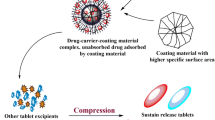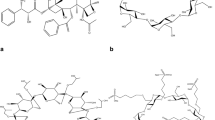Abstract
This study used actarit (ACT), an antirheumatic drug, to examine the molecular interaction of ACT and γ-CD in a solid state as a result of cogrinding or freeze-drying and it assessed the dissolution of ACT. Differential scanning calorimetry revealed that coground ACT and γ-CD at molar ratios of 1:2 and 1:3 and freeze-dried ACT and γ-CD at molar ratios of 1:1 and 1:2 lacked an endothermic peak due to melting of ACT crystals. Thus, coground ACT and γ-CD at a molar ratio of 1:2 had molecular interaction, as did freeze-dried ACT and γ-CD at a molar ratio of 1:1. Powder x-ray diffraction revealed that coground and humidified ACT and γ-CD at a molar ratio of 1:2 produced a characteristic diffraction peak at 2θ = 15.2° and 16.5° due to the cage structure of γ-CD. In addition, freeze-dried ACT and γ-CD at a molar ratio of 1:1 that had been humidified produced a diffraction peak at 2θ = 6.0° and 15.9° characteristic of a hexagonal structure with head-to-head channels due to γ-CD. Assessment of dissolution revealed that ground mixtures (GMs) and freeze-dried mixtures had improved dissolution of ACT compared to ACT, ground ACT alone, and physical mixtures. The mechanism for this is presumably the result of molecular interaction in a solid state or molecular interaction in an aqueous solution. 1H–1H NOESY NMR spectra suggested that in a GM of ACT and γ-CD the benzene ring and methyl group of ACT partially enter the CD cavity. In addition, spectra for freeze-dried ACT and γ-CD suggested that protons of the methylene group of ACT and the benzene ring of ACT partially enter the CD cavity. These findings indicate that ACT and γ-CD inclusion complexes feature different forms of inclusion depending on how they are prepared, e.g., cogrinding or freeze-drying. Findings also indicated that selection of a method of preparation may play a major role in drug development.






Similar content being viewed by others
References
Hu, J., Johnston, K.P., Williams, R.O.: Rapid dissolving high potency danazol powders produced by spray freezing into liquid process. Int. J. Pharm. 271, 145–154 (2004)
Pankajkumar, S.Y., Kumar, V., Pratap, S.U., Bhat, R.H., Mazumder, B.: Physicochemical characterization and in vitro dissolution studies of solid dispersions of ketoprofen with PVP K30 and d-mannitol. Saudi. Pharm. J. 22, 77–84 (2013)
Prabhu, S., Ortega, M., Ma, C.: Novel lipid-based formulations enhancing the in vitro dissolution and permeability characteristics of a poorly water-soluble model drug, piroxicam. Int. J. Pharm. 301, 209–216 (2005)
Wongmekiat, A., Tozuka, Y., Moribe, K., Oguchi, T., Yamamoto, K.: Preparation of drug nanoparticles by co-grinding with cyclodextrin: formation mechanism and factors affecting nanoparticle formation. Chem. Pharm. Bull. 55, 359–363 (2007)
Tao, T., Zhao, Y., Wu, J., Zhou, B.: Preparation and evaluation of itraconazole dihydrochloride for the solubility and dissolution rate enhancement. Int. J. Pharm. 367, 109–114 (2009)
Yeo, L., Kenneth, D., Harris, M.: Definitive structural characterization of the conventional low-temperature host structure in urea inclusion compounds. Acta. Cryst. B53, 822–830 (1997)
Miki, K., Masui, A., Kasai, N., Miyata, M., Shibakami, M., Takemoto, K.: New channel-type inclusion compound of steroidal bile acid. Structure of a 1:1 complex between cholic acid and acetophenone. J. Am. Chem. Soc. 110, 6594–6596 (1988)
Brewster, M.E., Loftsson, T.: Cyclodextrins as pharmaceutical solubilizers. Adv. Drug Deliv. Rev. 59, 645–666 (2007)
Dollo, G., Le, C.P., Chollet, M., Chevanne, F., Bertault, M., Burgot, J.L., Le, V.R.: Improvement in solubility and dissolution rate of 1,2-dithiole-3-thiones upon complexation with beta-cyclodextrin and its hydroxypropyl and sulfobutyl ether-7 derivatives. J. Pharm. Sci. 88, 889–895 (1999)
Hirayama, F., Uekama, K.: Cyclodextrin-based controlled drug release system. Adv. Drug Deliv. Rev. 36, 125–141 (1999)
Nagase, Y., Hirata, M., Wada, K., Arima, H., Hirayama, F., Irie, T., Kikuchi, M., Uekama, K.: Improvement of some pharmaceutical properties of DY-9760e by sulfobutyl ether beta-cyclodextrin. Int. J. Pharm. 229, 163–172 (2001)
Cabral-Marques, H., Almeida, R.: Optimisation of spray-drying process variables for dry powder inhalation (DPI) formulations of corticosteroid/cyclodextrin inclusion complexes. Eur. J. Pharm. Biopharm. 73, 121–129 (2009)
Mangolim, C.S., Moriwaki, C., Nogueira, A.C., Sato, F., Baesso, M.L., Neto, A.M., Matioli, G.: Curcumin-β-cyclodextrin inclusion complex: stability, solubility, characterisation by FT-IR, FT-Raman, X-ray diffraction and photoacoustic spectroscopy, and food application. Food. Chem. 153, 361–370 (2014)
Iwata, M., Fukami, T., Kawashima, D., Sakai, M., Furuishi, T., Suzuki, T., Tomono, K., Ueda, H.: Effectiveness of mechanochemical treatment with cyclodextrins on increasing solubility of glimepiride. Pharmazie. 64, 390–394 (2009)
Ogawa, N., Higashi, K., Nagase, H., Endo, T., Moribe, K., Loftsson, T., Yamamoto, K., Ueda, H.: Effects of cogrinding with <beta>-cyclodextrin on the solid state fentanyl. J. Pharm. Sci. 99, 5019–5029 (2010)
Uekama, K., Hirayama, F., Ikeda, K., Inaba, K.: Utilization of cyclodextrin complexation for separation of E, A, and B prostaglandins by ion-exchange liquid chromatography. J. Pharm. Sci. 66, 706–710 (1977)
Al Omari, A.A., Al, O.M.M., Badwan, A.A., Al-Sou’od, K.A.: Effect of cyclodextrins on the solubility and stability of candesartan cilexetil in solution and solid state. J. Pharm. Biomed. Anal. 54, 503–509 (2011)
Torikai, E., Kageyama, Y., Takahashi, M., Nagano, A.: The effect of methotrexate on bone metabolism markers in patients with rheumatoid arthritis. Mod. Rheumatol. 16, 350–354 (2006)
Ye, J., Wang, Q., Zhou, X., Zhang, N.: Injectable actarit-loaded solid lipid nanoparticles as passive targeting therapeutic agents for rheumatoid arthritis. Int. J. Pharm. 352, 273–279 (2008)
Inoue, Y., Yamazoe, T., Watanabe, S., Murata, I., Kanamoto, I.: Examination of intermolecular interaction as a result of cogrinding actarit and β-cyclodextrin. J. Incl. Phenom. Macrocycl. Chem. 78, 457–464 (2014)
Xiao, C.F., Li, K., Huang, R., He, G.J., Zhang, J.Q., Zhu, L., Yang, Q.Y., Jiang, K.M., Jin, Y., Lin, J.: Investigation of inclusion complex of epothilone A with cyclodextrins. Carbohydr. Polym. 102, 297–305 (2014)
Inoue, Y., Hasegawa, N., Tozuka, Y., Yonemochi, E., Oguchi, T., Higashi, K., Moribe, K., Yamamoto, K.: Molecular states of p-dimethylaminobenzonitrile coground with β-cyclodextrin investigated using solid-state fluorescence spectroscopy. Chem. Pharm. Bull. 59, 1299–1302 (2011)
Chung, J.W., Guo, Y., Priestley, R.D., Kwak, S.Y.: Colloidal gold nanoparticle formation derived from self-assembled supramolecular structure of cyclodextrin/Au salt complex. Nanoscale. 3, 1766–1772 (2011)
Toropainen, T., Heikkilä, T., Leppänen, J., Matilainen, L., Velaga, S., Jarho, P., Carlfors, J., Lehto, V.P., Järvinen, T., Järvinen, K.: Crystal structure changes of gamma-cyclodextrin after the SEDS process in supercritical carbon dioxide affect the dissolution rate of complexed budesonide. Pharm. Res. 6, 1058–1066 (2007)
Higashi, K., Ideura, S., Waraya, H., Limwikrant, W., Moribe, K., Yamamoto, K.: Simultaneous dissolution of naproxen and flurbiprofen from a novel ternary gamma-cyclodextrin complex. Chem. Pharm. Bull. 58, 769–772 (2010)
Anzai, K., Mizoguchi, J., Yanagi, T., Hirayama, F., Arima, H., Uekama, K.: Improvement of dissolution properties of a new Helicobacter pylori eradicating agent (TG44) by inclusion complexation with beta-cyclodextrin. Chem. Pharm. Bull. 55, 1466–1470 (2007)
Acknowledgments
The authors wish to thank Cyclo Chem Co. Ltd. for providing γ-CD. The authors also wish to sincerely thank Nippon Shinyaku Corporation for providing ACT.
Author information
Authors and Affiliations
Corresponding author
Rights and permissions
About this article
Cite this article
Inoue, Y., Watanabe, S., Suzuki, R. et al. Evaluation of actarit/γ-cyclodextrin complex prepared by different methods. J Incl Phenom Macrocycl Chem 81, 161–168 (2015). https://doi.org/10.1007/s10847-014-0445-z
Received:
Accepted:
Published:
Issue Date:
DOI: https://doi.org/10.1007/s10847-014-0445-z




